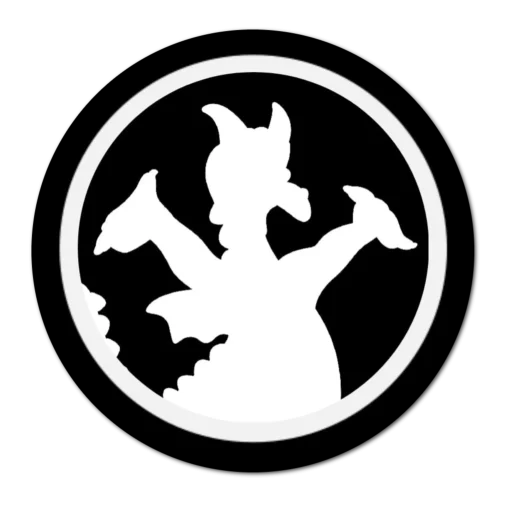(A version of this post was shared with Laughing Place on May 23, 2025.)
Ready or not, Donkey Kong has arrived at Universal Orlando’s Epic Universe theme park! The 500-pound gorilla has been swinging his way through video games and other media for over forty years, and now he’s found his way to Orlando, Florida.
Mine-Cart Madness – a fun and frenzied rollercoaster attraction – is now running the rails in Donkey Kong Country, part of Epic Universe’s Super Nintendo World
Let’s celebrate the arrival of Donkey Kong with a fascinating look at the history of the iconic ape.
Nintendo’s Low-Tech Beginning
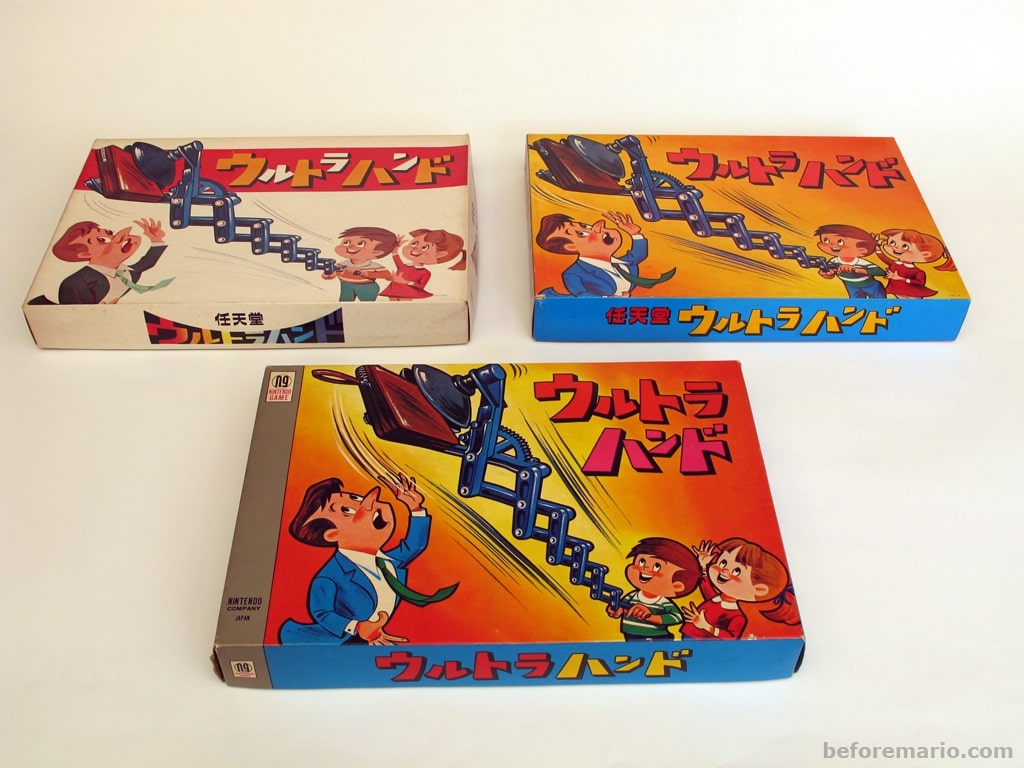
For nearly a century before the arcade explosion of the 1980s, video game giant Nintendo had been a mainstay in gaming culture – at least in Japan – by producing Japanese playing cards. In the 1950s, Nintendo added table games to its offerings, and in the 1970s, electronic toys found their way into the company fold. The 1973 global oil crisis, and the associated high costs of material production and shipping caused Nintendo to shift its focus from playing cards and games to arcade games.
Nintendo’s first volley into the arcade arena was a 1980 shooting game called Radar Scope, which was meant to counter Taito’s 1978 arcade smash Space Invaders. Unfortunately, Radar Scope was a commercial failure, and put the gaming company in a financial crisis. Nintendo CEO Hiroshi Yamauchi was looking for a new arcade game that could repurpose the many unsold arcade cabinets created for the failed game. With most of Nintendo’s top developers busy working on other projects, the task went to first-time game designer Shigeru Miyamoto.
Bizarre Love Triangle
Recognizing his golden opportunity to impress, Miyamoto was looking to do something different. Instead of a shooting game based on a single level with increased difficulty, he envisioned a story resembling a playable comic strip that could progress over multiple levels – each with unique scenarios and challenges. And he wanted to do it using relatable characters.
Miyamoto settled on a “love triangle” story involving characters who are surprisingly popular in Japan – Popeye, Bluto, and Olive Oyl from the Popeye the Sailor franchise. The game’s premise was for Bluto – Popeye’s dim-witted adversary – to kidnap Olive Oyl (as he often did in comics and cartoons) with the spunky sailor springing into action to rescue his lady.

There have been numerous Popeye video games developed across gaming systems throughout the years, but in 1980, Nintendo wasn’t able to strike a deal with King Features to make a Popeye game of their own.
Undeterred by the rejection, Miyamoto kept his idea but pivoted on the characters. Bluto the bully evolved into a giant gorilla who captures a more generic damsel in distress. The hero of the game, with a sort of “everyman” appearance, was tasked with rescuing the girl.
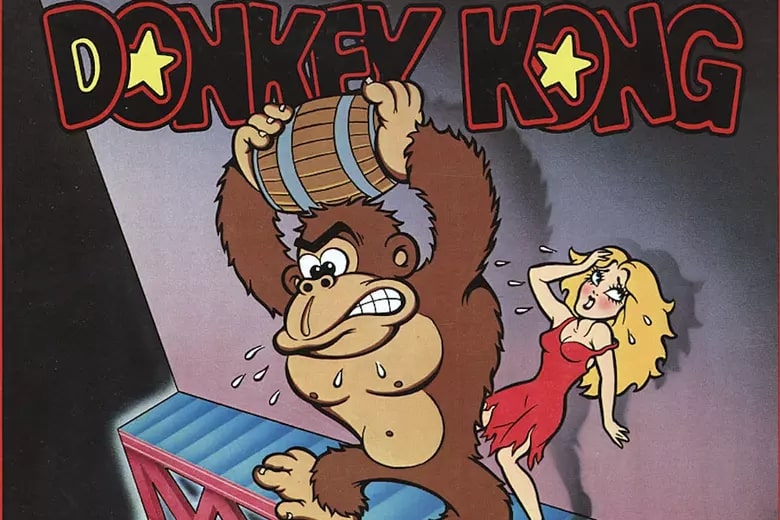
Sound familiar? Miyamoto’s game – Donkey Kong – follows the story of Mario as he climbs a treacherous construction site to rescue Pauline from a gorilla named Donkey Kong (who, lore states, happens to be Mario’s escaped pet). That’s the whole premise. But for a video game released in 1981, that was plenty.
Fun Fact: While we all know the hero of Donkey Kong as Mario, when the game was first released, the character was given the uninspiring name Jumpman. His name was later retconned to Mario, in what would be the first of his many appearances throughout Nintendo’s storied video game history.
What’s in a Name?
When deciding on a name for the game’s titular character, Miyamoto used his limited understanding of English and selected a compound name using Donkey to imply the sense of being stubborn (a slight misfiring of the expression “stubborn as a mule”), and Kong to imply the imposing size of a gorilla. Just like that, a simian star was born.
Even without playing the game or knowing the character, hearing the name Donkey Kong conjures an image of an imposing adversary, largely due to the world’s most famous gorilla, King Kong. But in 1982, this became a problem for Nintendo. The film studio Universal City Studios filed a lawsuit against Nintendo, claiming Donkey Kong violated its trademark of King Kong.
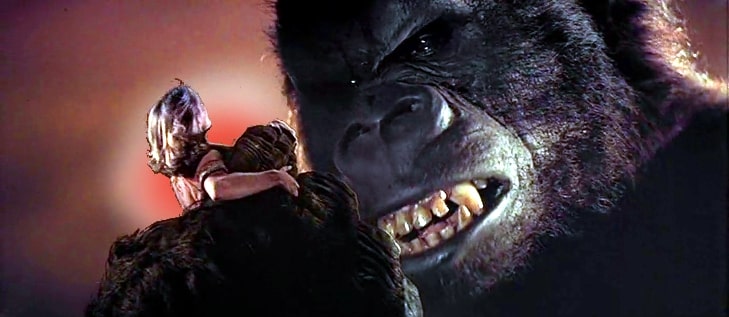
Nintendo employed the legal prowess of lawyer John Kirby, who successfully argued that the plot and characters of King Kong were located in the public domain. Judge Robert Sweet declared that “at best, Donkey Kong is a parody of King Kong.” The most ironically hypocritical moment in the trial came when Kirby noted that Universal City themselves had sued RKO Pictures in 1975, stating the King Kong was in the public domain, so that producer Dino De Laurentis could make an updated version of the classic 1933 film. Suffice to say, Kirby won the lawsuit for Nintendo, and Donkey Kong stuck.

Fun Fact: In gratitude for the legal victory, Nintendo gave John Kirby a boat named Donkey Kong, and also named a major video game character after him. Kirby – a happy pink puff character with his own successful franchise – was originally going to be named Popopo until his name was changed as a tribute to Nintendo’s heroic lawyer.
DK’s Blockbuster Success
In the months leading up to Donkey Kong’s release, Miyamoto and his team were told the game would be a failure. But those predictions could not have proved more wrong. Donkey Kong became Nintendo’s first major international success upon its release in July 1981. The game’s $280 million windfall rescued Nintendo from a financial crisis, and established it as one of the top gaming brands in America.

Donkey Kong achieved further success in 1982, when Nintendo released a Game & Watch adaptation and licensed it to gaming platform Coleco for use in home gaming consoles. All told, the Donkey Kong franchise has grossed nearly $4.4 billion across various platforms since 1981, making it one of the highest-grossing game franchises of all time.
Fun Fact: Donkey Kong was the first game to deepen the game story using cutscenes. These are the non-playable animated scenes in between game levels. Most modern video games use cutscenes to tell their story, but Donkey Kong was the first.
Another Fun Fact: Donkey Kong is widely credited for being the first platform-based video game, featuring jumping, platform-based gameplay and single-screen, side-scrolling perspective.
Bring on the Sequels
Success breeds success, and the original Donkey Kong proved to be just the first in a barrel full of golden bananas. Let’s look at some additional games from the Donkey Kong universe.
Donkey Kong Jr. (1982)
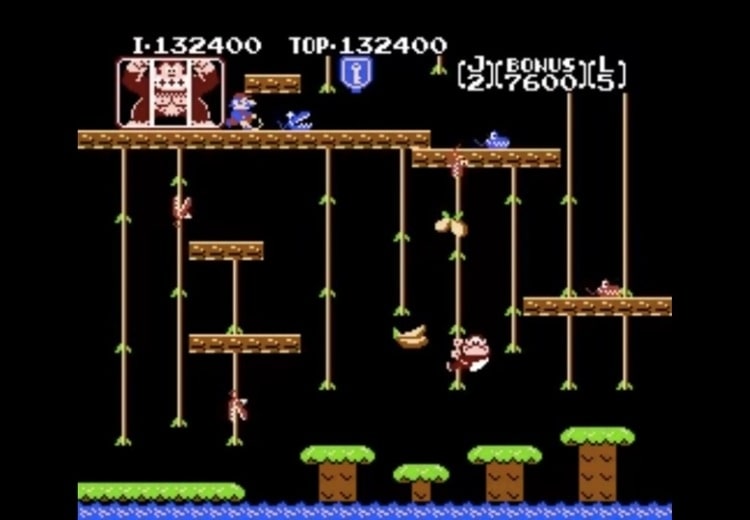
Nintendo didn’t wait long before releasing a follow-up to their smash hit. Miyamoto wanted to turn the tables and make Donkey Kong the protagonist, but the character’s sprite graphic was too large to easily maneuver through a game sequence. So Miyamoto gave Donkey Kong a son – appropriately named Donkey Kong Jr. – and tasked him with saving his father, who was now captured and caged by Mario. Donkey Kong Jr. was a sequel success, and continued Nintendo’s newfound arcade dominance.
Donkey Kong 3 (1983)
The third and final game from the original series of Donkey Kong games was not nearly as impressive or popular as its predecessors. Donkey Kong 3, released in 1983, departed from platform-style play, instead offering a shooting-style experience where the player controls Stanley, a human exterminator who must fend off Donkey Kong and a swarm of bees (which he is aggressively agitating). With Donkey Kong 3’s steep decline in game imagination and popularity, Nintendo decided to put the ape on the shelf and focus on other arcade game ideas.
Donkey Kong (1994)
Following a ten-year hiatus, Nintendo released a new game (also called Donkey Kong) for their GameBoy handheld system in 1994. Like the original, this game features Mario as the player character for the first several levels, but then the game opens up to over 100 additional puzzle-platforming levels, organized in different levels to give the game a further sense of quest.
Fun Fact: This 1994 GameBoy game was the first Donkey Kong game to depict Donkey Kong wearing his signature red necktie bearing his initials, “DK”.
Donkey Kong Country (1994)
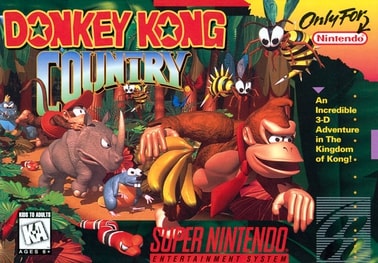
When Donkey Kong was first released in arcades, it broke the mold for giving video games personality. In 1994, Nintendo struck gold again with Donkey Kong Country – first released for the Super Nintendo Entertainment System (SNES).
Donkey Kong Country was one of the first games created for a mainstream home video game console to use pre-rendered graphics – a process using a compression technique to convert 3D models into smaller sprite graphics with little loss of detail. The result was a beautifully-animated story with nimble playability that re-established Donkey Kong as a major Nintendo franchise.
The groundbreaking game added an enchanting music soundtrack, mixing natural environmental sounds with prominent melodic and percussive accompaniments. The New York Times went so far as to call the game’s soundtrack “the video game equivalent to The Beatles’ Revolver (1966) or Sgt. Pepper’s Lonely Hearts Club Band (1967).”
Another enhancement Donkey Kong Country featured was a significantly increased cast of characters. The initial series of Donkey Kong games included only a very small cast of characters (namely, Donkey Kong, Mario, Pauline, Donkey Kong Jr., and a few other minor characters). In creating Donkey Kong Country, game designer Rare Limited had the opportunity to greatly expand the Donkey Kong Universe, adding such characters as Donkey Kong’s sidekick Diddy Kong (who replaced Donkey Kong Jr.) and the antagonistic Kremlings, with their ruler King K. Rool, among many others.
Donkey Kong Country was a major success, selling 9.3 million copies and becoming the third-best selling Super Nintendo game. The game’s massive success spawned two sequels, including Donkey Kong Country 2: Diddy’s Kong Quest (1995), and Donkey Kong Country 3: Dixie Kong’s Double Trouble! (1996). Characters from the Donkey Kong Country trilogy have persisted far beyond the three games, appearing in other Nintendo fare over subsequent years.
The Expanded Donkey Kong Universe
Donkey Kong’s renewed popularity in the mid-1990s lead to a boom in additional Donkey Kong-branded games, including:
- Donkey Kong Land (1995), Donkey Kong Land 2 (1996), and Donkey Kong Land III (1997) for Nintendo Gameboy
- Diddy Kong Racing (1997) for Nintendo 64
- Donkey Kong 64 (1999) for Nintendo 64
- Donkey Konga (2003) and Donkey Konga 2 (2004) for Nintendo GameCube
- Donkey Kong Jungle Beat (2004) for GameCube
- Donkey Kong Country Returns (2010) for the Nintendo Wii (followed by versions on the Nintendo 3DS and Switch)
- Donkey Kong Country: Tropical Freeze (2014) for the Wii U (followed by a version for the Nintendo Switch)
The newest game in the Donkey Kong franchise is Donkey Kong Bananza, scheduled for release for the Nintendo Switch 2 in July 2025.
Donkey Kong Outside His Own Universe
Outside his own land, Donkey Kong has appeared in many other Nintendo games over the years. Let’s look at a few of them here.
Super Mario Kart

In 1991, three years prior to Donkey Kong’s resurgence, Nintendo began discussing a Donkey Kong revival to celebrate the original arcade game’s tenth anniversary. The company was not prepared to create a full new Donkey Kong game at that time, but they did honor him by including Donkey Kong Jr. as a playable character in Super Mario Kart (1992). The adorable and endlessly entertaining (and often anxiety-inducing) racing game has persisted with versions for virtually every Nintendo gaming system since the Super Nintendo, and Donkey Kong (and a few of his friends) have had a presence the whole way.
Super Smash Bros.
Nintendo introduced a series of crossover fighting games in 1999, with the debut of Super Smash Bros. Donkey Kong debuted in the original 1999 version as the only heavyweight fighter, with powerful (but slow) attacks. His tiny sidekick Diddy Kong, and archenemy King K. Rool were added in subsequent versions. This super-popular series of games also features occasional Donkey Kong stages and music, adding a little DK flavor to the event.
Mario vs. Donkey Kong
In 2004, Nintendo paired Donkey Kong with Mario for the first of what would become a sub-franchise of puzzle-platform games. Of all the Donkey Kong games since the original, Mario vs. Donkey Kong is the most similar to the arcade classic, with players navigating Mario through challenges to find keys and rescue adorable Mini-Marios from Donkey Kong.
Donkey Kong in Sports Games
Donkey Kong is no stranger to the sports arena. He appears as a playable character in Mario & Sonic at the Olympics (2007), a game system crossover between Nintendo’s Mario franchise and Sega’s Sonic the Hedgehog franchise.
The big gorilla also appeared in the Wii’s version of Punch-Out!! (2009) as one of boxer Little Mac’s tougher opponents.
Donkey Kong’s Community
Donkey Kong’s population has grown greatly over the years, after modest beginnings featuring a small cast of only three characters. There are far too many jungle personalities to list them all, but here are a few of the main ones.
Mario
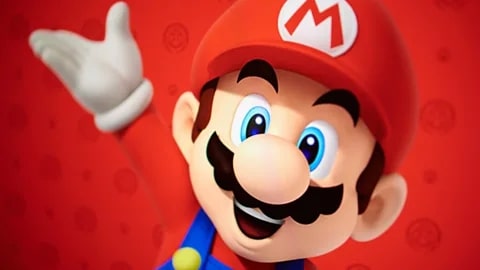
No discussion of Donkey Kong is complete without mentioning the game’s hero (who also happens to be the world’s most famous plumber). Mario isn’t just the hero of the original Donkey Kong game – he’s a cultural icon, the most famous video game character of all time, and the face of Nintendo’s mammoth video game empire. Truth be told, Mario has surpassed Donkey Kong in popularity ten-fold. The portly plumber traded his original hammer for a pipe wrench over forty years ago, and has appeared in over 200 Nintendo video games since – many of them as the primary character. He also headlines the Super Nintendo World areas of several of Universal’s theme parks worldwide.
Donkey Kong Jr.
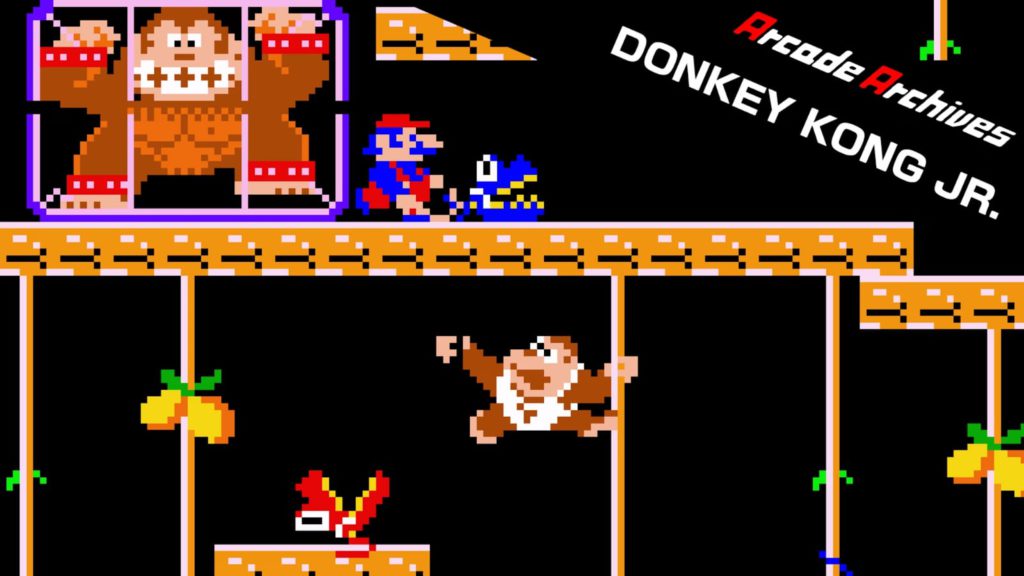
This son of the original Donkey Kong straddled the vines in 1982 wearing nothing more than a white onesie. He later appeared in 1992’s Super Mario Cart, and has made occasional appearances in other Donkey Kong and Nintendo games. Often referred to as “DKJ”, Junior has faded considerably from the spotlight thanks to the introduction of the charismatic Diddy Kong.
Cranky Kong

Also known as Donkey Kong Sr., Cranky Kong was introduced in Donkey Kong Country as a grumpy elderly gorilla, known for his sarcastic comments. His main purpose in the Donkey Kong Country games is to offer helpful hints and guidance to players.
Fun Fact: At one point, official DK lore said Cranky Kong was actually the original Donkey Kong, which would make the original Donkey Kong Jr. be the Donkey Kong of the Donkey Kong Country series. However, Nintendo later corrected this relationship, making Cranky Kong the grandfather of the original Donkey Kong. Confused? So is Nintendo. Don’t worry, you won’t be quizzed.
Diddy Kong
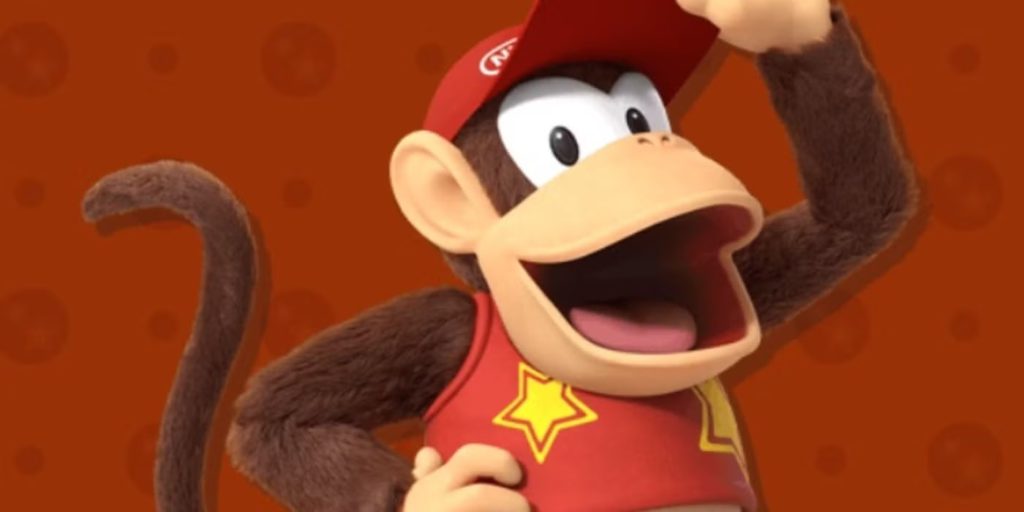
Of all the characters in the expanded Donkey Kong universe, Diddy Kong may be the most popular (aside from the original ape himself). Originally conceived as a spider monkey, Diddy (whose name means “small” in some British slang) lives with Donkey Kong on Donkey Kong Island. He stands out in the crowd despite his tiny size, with a red hat and red shirt. During the development of Donkey Kong Country, Diddy was originally planned to be an updated version of Donkey Kong Jr., but Nintendo didn’t like the inconsistency in appearance. Diddy was instead introduced as a friend of Donkey Kong. The tiny simian has endured in many games since his 1994 debut, particularly as one of the better racers in the Super Mario Kart series.
Dixie Kong
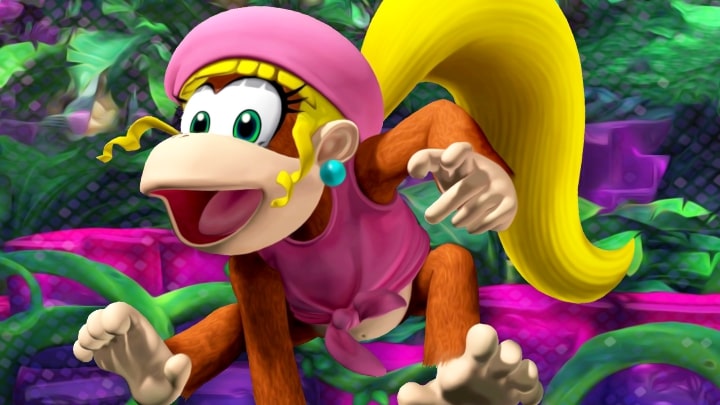
Perhaps even smaller in size than Diddy Kong is his girlfriend Dixie Kong, a young chimpanzee donned in all pink, strutting the swagger of a champion. Dixie first appeared in Donkey Kong Country 2: Diddy’s Kong Quest as an “inseperable friend” to Diddy. She had a starring role as the main hero in Donkey Kong Country 3: Dixie Kong’s Double Trouble!, and numerous appearances in other DK games. Dixie’s cute ponytail is not just for show – it allows her to grasp and swing from objects. It’s quite an effective tool!
Candy Kong
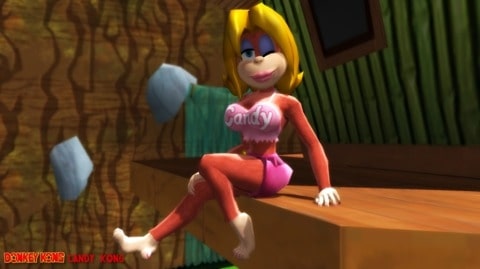
Finally, we get to Donkey Kong’s girlfriend! Candy Kong – DK’s main squeeze – first appeared in Donkey Kong Country providing save point stations throughout the game. While she hasn’t been a major character in the franchise, Candy does appear semi-regularly throughout the DK game series – usually wearing a swimsuit and sneakers.
Funky Kong
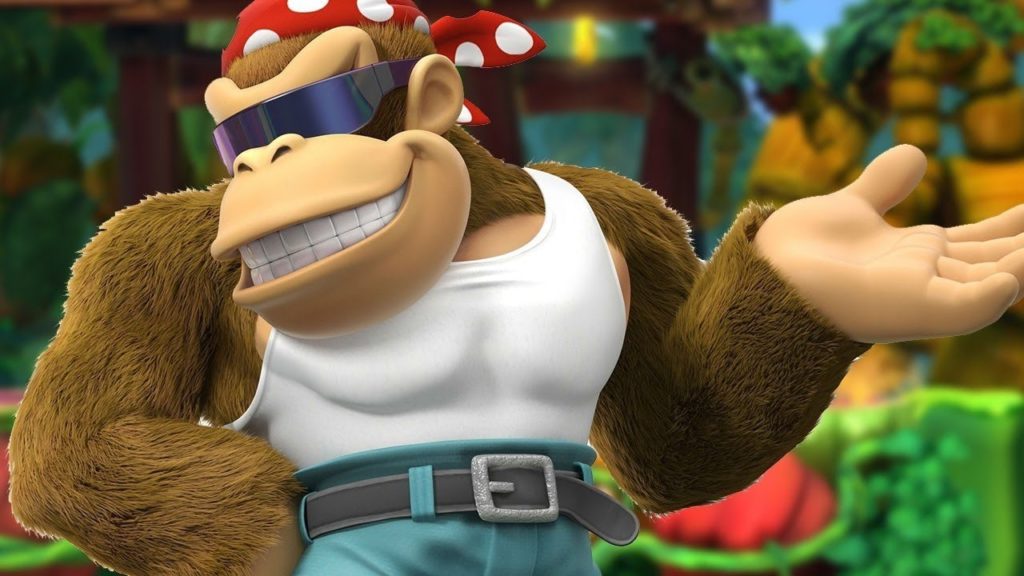
“Surf’s up!”
Funky Kong is his own ape – a cool surfer gorilla and a jack-of-all-trades. Funky serves largely as transportation, allowing players to travel back and forth to completed worlds. The enterprising ape also sells vehicles, ammunition, and other supplies. Like many other DK characters, Funky appears occasionally in other Nintendo fare, most notably as an unlockable driver character in Mario Kart Wii.
The Bad Guys
With Donkey Kong becoming the hero in many games throughout the DK franchise, you may wonder who are the bad guys? Like many games, the villains take many forms. Here are a few of them.
Kremlings
The Kremlings are a species of crocodiles, native to the appropriately named Crocodile Isle. They come in many sizes, varieties, and colors. Most have names beginning with K, and sport their own personalities and abilities, such as Kritter, who can use tools, and Krockhead, who loves hiding in swamps or lava.
King K. Rool
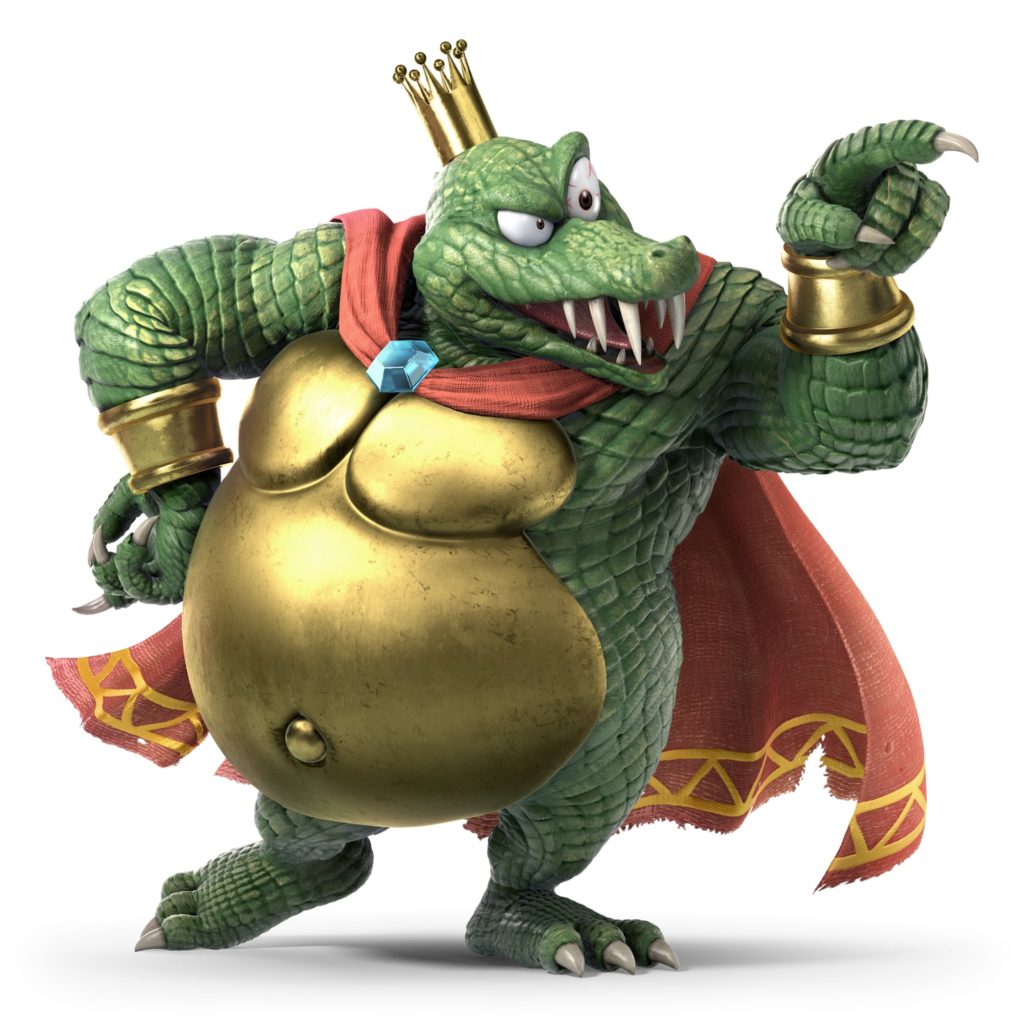
Donkey Kong’s main enemy throughout the Donkey Kong Country series (and beyond) is King K. Rool – the red caped leader of the Kremlings. The top croc is big and burly, unstable and unpredictable, and also very sneaky. He often adopts different names and aliases, and uses different weapons to his advantage.
Klumps
Some of the more powerful Kleming crocs are known as Klumps. These large, round Klemings show up as tougher foes and level bosses. Klumps tend to sport military gear, with green helmets, utility belts, and boots.The Klumps’ helmets help them withstand Diddy Kong’s jump attacks, but DK can still take them down with a single hit.
Tiki Tak Tribe

This primitive group of Tiki-like demons resemble musical instruments, and are the main villains in Donkey Kong Country Returns. As the story goes, the Tiki Tak Tribe emerged from a volcanic eruption at the start of the game, and the higher-ranking members of the tribe hypnotized the wildlife on Donkey Kong Island into stealing bananas. Only Donkey Kong and Diddy Kong remain unhypnotized, as they work to regain their precious fruit. The tribe is led by Tiki Tong, a gigantic and bongo drum-like Tiki.
The Sidekicks
Good hero stories often feature charming sidekicks, and video games are no exception. Donkey Kong has enjoyed the help of a few friends over the years. Here are a couple of the most notable.
Rambi
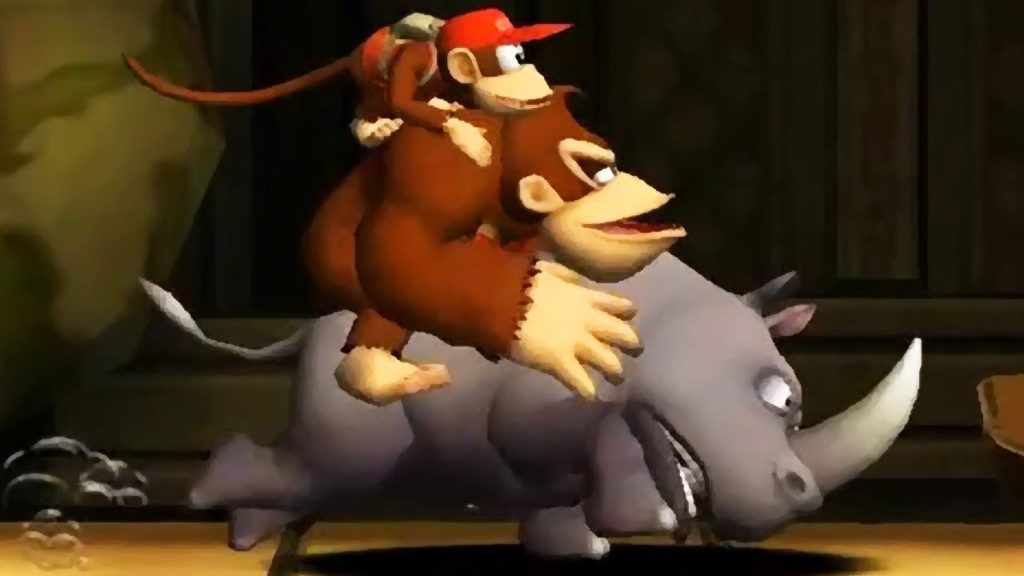
You can probably guess Rambi’s strength from his name alone. This Indian rhinoceros debuted in Donkey Kong Country, and has appeared in many DK games since. True to his name, Rambi can charge and ram through enemies and walls. Helping DK to access areas otherwise inaccessible. Smaller, baby rhinos resembling Rambi – called RamRams – make an adorable appearance in Mario vs. Donkey Kong.
Squawks
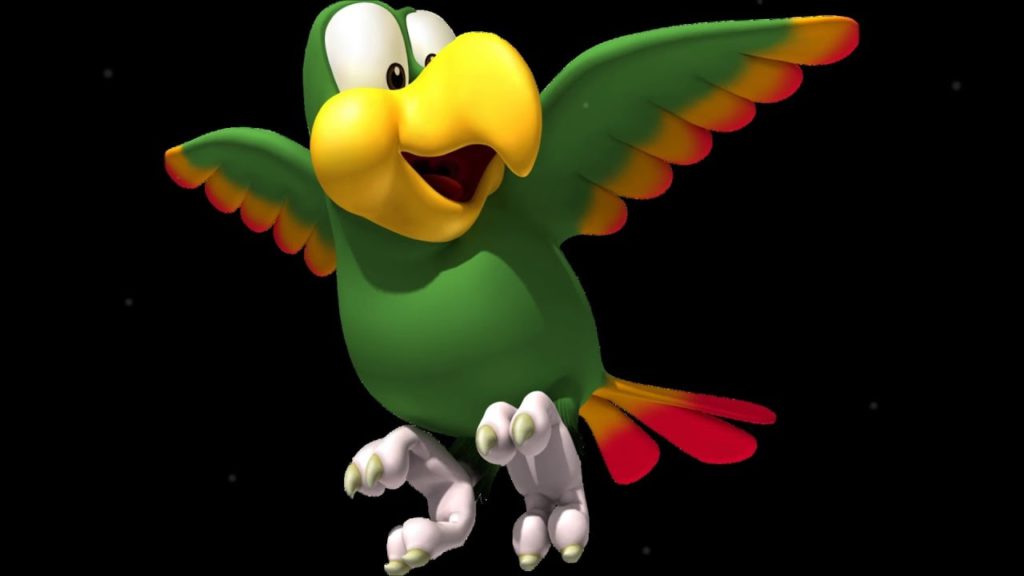
Like Rambi, Squawks the parrot appears in many Donkey Kong games, beginning with Donkey Kong Country. In many games, Squawks can carry Kongs through the air, though at times he serves better by carrying a spotlight through dark levels. One of Squawks’ most effective (and oddly endearing) strengths is to spit crackers at his enemies – defeating most of them!
Donkey Kong on Television and Film
Despite his persistent presence in video games, Donkey Kong has only made a select few appearances on television and film. A Donkey Kong cartoon aired as part of CBS’s hour-long Saturday Supercade program in 1983. With only a few characters in the franchise at that time, the show follows Mario and Pauline as they attempt to capture Donkey Kong after he escapes from a circus. The series was panned as a huge flop, despite some key voice talents (comedy legend Soupy Sales as Donkey Kong and Frank Welker [the legendary voice of Transformer Optimus Prime] as Donkey Kong Jr.).

Donkey Kong returned to television in 1997, riding the enormous success of Donkey Kong Country. The show, aptly-named Donkey Kong Country, takes a sitcom approach to storytelling, following Donkey Kong as he attempts to protect a magical artifact – the Crystal Coconut – from King K. Rool. This series was considerably more successful than its predecessor, running for three seasons and a total of 40 episodes. It was produced using computer animation and motion capture technology.
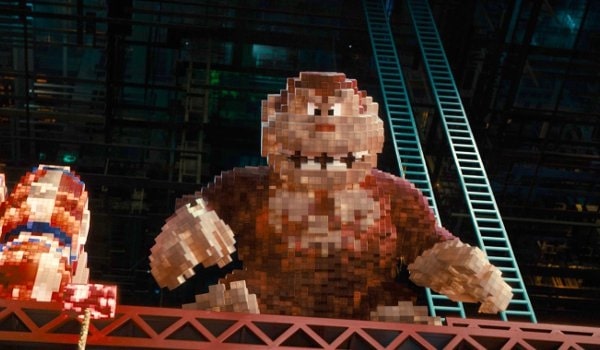
Donkey Kong made his film debut in the 2015 Adam Sandler film Pixels, as the final form of the arcade villain. This version of DK was not nearly so cuddly or endearing as the one we know and love, though he was certainly larger-than-life in the film.
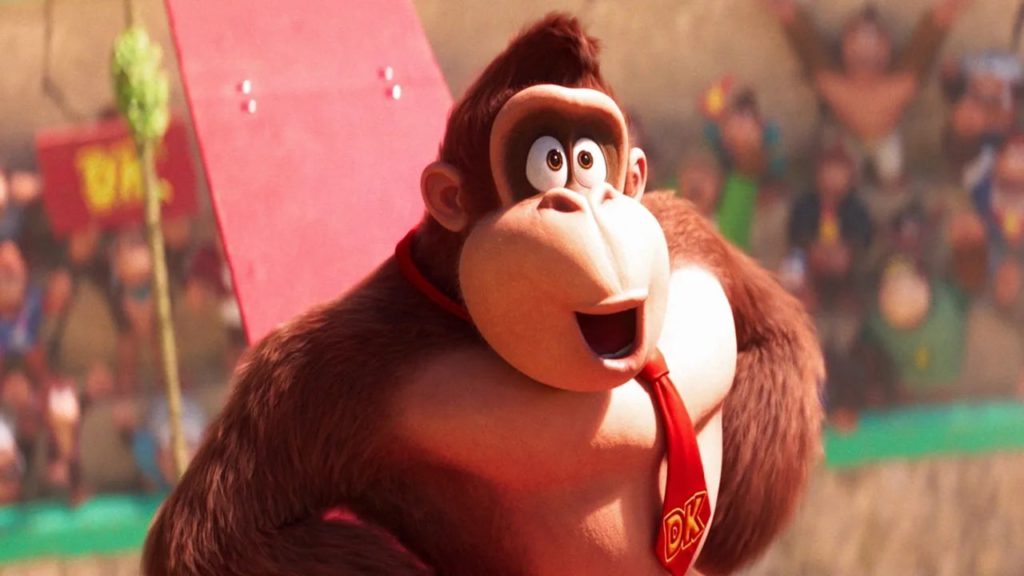
DK had a larger and more amiable role in the 2023 animated film The Super Mario Bros. Movie. In the film, Donkey Kong – voiced by comedian Seth Rogen – squares off with Mario in a jungle brawl, only to be outsmarted by his long-time nemesis. Following his defeat, DK came around to help Mario and his friends defeat Bowser and save Mushroom Kingdom. The Super Mario Bros. Movie made over $1 billion at the international box office, ensuring that we will enjoy a sequel (and likely more Donkey Kong with it) in the near future.
Mine-Cart Madness
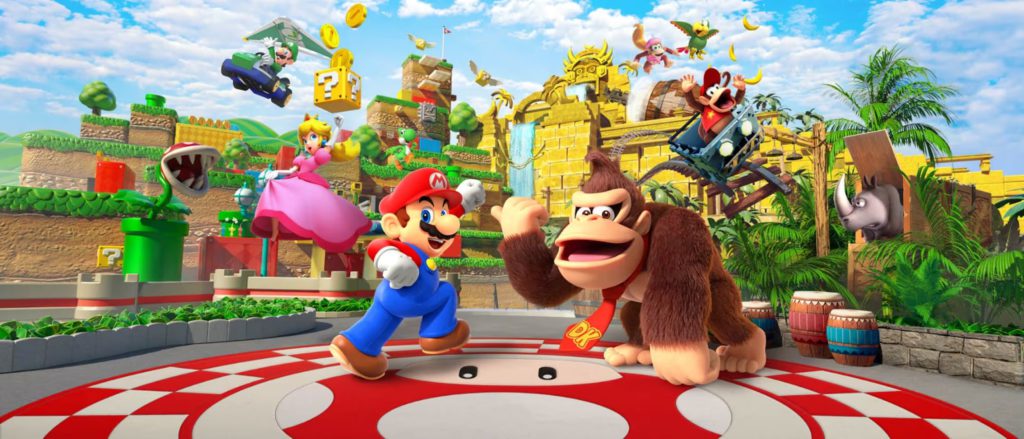
In December 2024, Donkey Kong became more real than ever inside the Universal Studios Japan theme park. Donkey Kong Country opened on December 11th as part of Super Nintendo World, a land within the theme park. The signature attraction in the land is the stunning family coaster ride Mine-Cart Madness, taking guests on a frantic mine cart to help Donkey Kong protect the Golden Banana. On the coaster, guests “speed through the mine, appear to jump across gaps in the track, and perform other eye-popping feats from the Donkey Kong Country video games.” Many of the most popular characters from the DK universe appear in the attraction, including Donkey Kong, Diddy Kong, Dixie Kong, Cranky Kong, Squawks the parrot, and the pesky Tiki Tak Tribe.
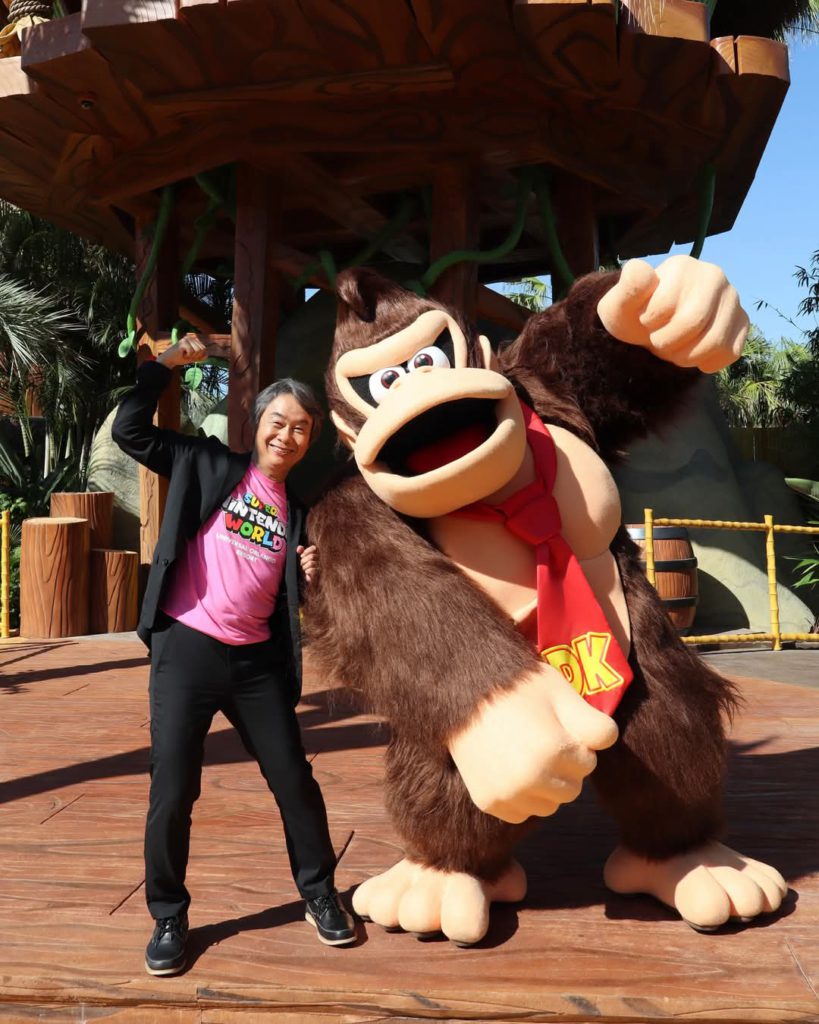
Image: Universal
Donkey Kong Country and Super Nintendo World are officially open in Universal Orlando’s Epic Universe as of May 22, 2025.
Let’s hear from you! Are you a Donkey Kong fan? Have you ever played the original arcade game? Do you dare take a ride on DK’s mine cart in Universal’s Epic Universe? Let me know what you think with a message on social: Instagram Facebook X
Are you interested in visiting Universal Orlando to experience Epic Universe for yourself? Reach out to Facts and Figment Vacation Planning to get the ball rolling. My travel planning services are absolutely FEE-FREE to you, and I can help you score the best, hardest-to-get deals to make your vacation more affordable and magical!
